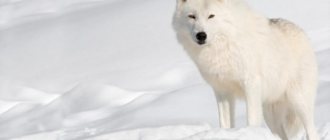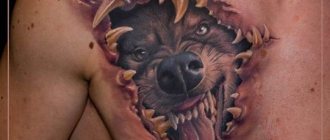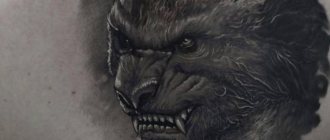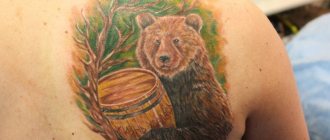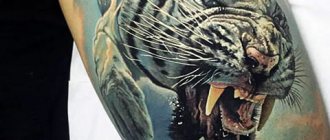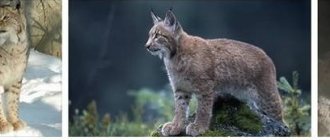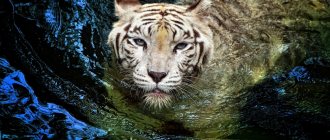The wolf is the largest predator of the canine family. The closest relatives of wolves are the coyote and jackal, which are also in the wolf genus. The wolf is the ancestor of the domestic dog, which is regarded by scientists as a subspecies of the wolf. Wolves form packs that have a clear hierarchy. A pack of wolves living near a settlement can cause serious damage to pets or even attack humans. The wolf has long been the enemy of man, and it has long been hunted. Let's talk about wolves in more detail.
Appearance
The wolf is the largest of the animals in the canine family, not counting some large breeds of domestic dogs, in appearance it resembles a large dog, which is not surprising since wolves are the ancestors of domestic dogs.
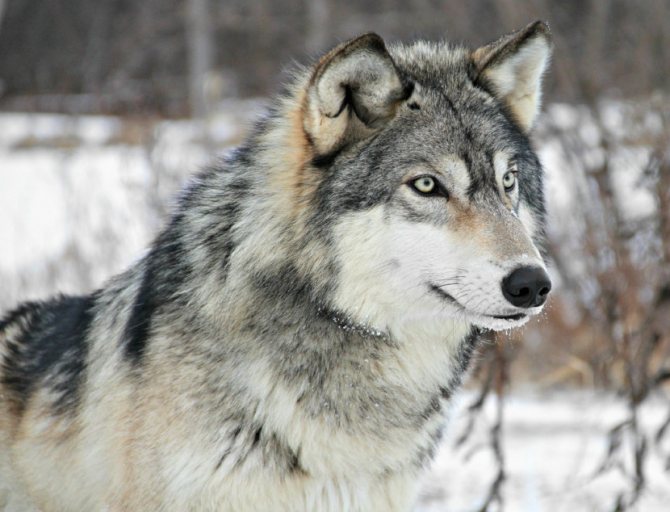
Most wolves predators of medium to large size, the body length of a wolf can be up to 110-160 cm, the height of the wolf at the withers can be from 60 to 90 cm. Tail length up to 52 cm.
Wolf body weight reaches up to 80 kg, there are some mentions of wolves reaching 90-100 kg. Usual weight of a yearling wolf is 20-30 kg, weight of a perejarok (2-3 years) 35-45 kg and weight of a mature wolf (over 3 years) from 50 kg and more.
The size and weight of wolves strongly depend on the geographical location of their habitat and correspond to Bergman's rule: the colder the climate, the larger the animal. That is why the largest wolves live in Siberia, Canada and Alaska. In 1939, a wolf weighing 80 kg was caught in Alaska. There is information that in Siberia a wolf weighing 92 kg has been caught.
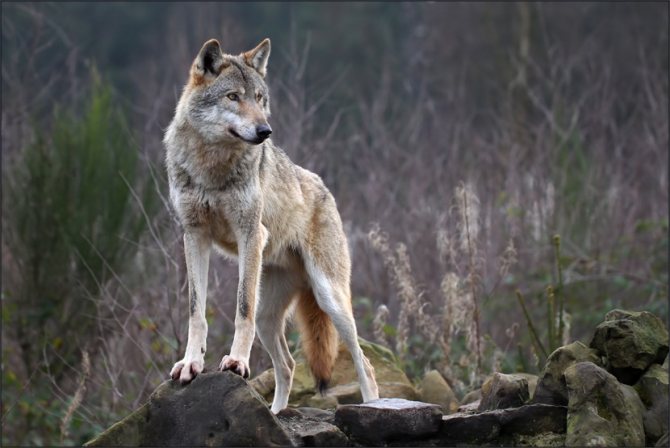

The average wolf from Europe usually weighs about 38 kg, the wolf from North America weighs 36 kg. The smallest wolves live in India and on Arabian Peninsula: their common weight is 25 kg and female wolf weighs even less, she weighs only 10 kg.
Females differ from males in their appearance, they are smaller in weight and size by about 20%, in addition to having a less shaggy head.
Wolves are very strong animals; they are so strong that they can turn over a frozen carcass of a large wild boar or elk.
Wolf's head is massive, broad-shouldered, with high set triangular ears that resemble those of barks or German shepherds. The wolf's muzzle is broad and elongated and has 'sideburns' on the sides. The wolf's muzzle is very different from that of the jackal or coyote, which are sharper and narrower. The wolf's large muzzle is very expressive, the wolf can express more than 10 emotions with its facial expression: anger, anger, affection, amusement, wariness, submissiveness, threat, calmness and fear. Cheeks of the wolf is almost white, with light spots in the eye area. The nasal opening is wide, extending downward.
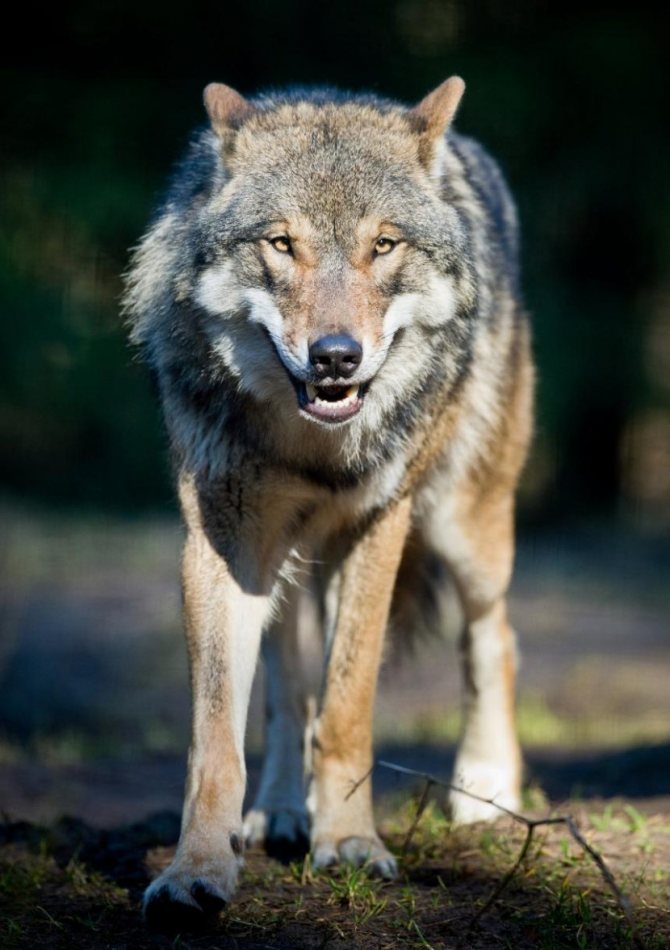

Females have a narrower muzzle, with a narrower forehead and a thinner neck.
The wolf's eyes can see well in the dark, thanks to a reflective layer that glows in the dark.
The wolf looks like a mighty and dangerous predator, slender, with a strong mighty build, a muscular neck and a taut belly. This evolutionary process gave the wolf a deep-set, narrow and streamlined chest, high strong legs, and a sloping back, all of which allows the wolf to travel long distances in search of prey.
The wolf's teeth play an important role in its life. They can withstand more than 10 megapascals and are both weapons of attack and defense for the wolf. Loss of teeth leads to starvation and subsequent death of the wolf.
The wolf's mouth contains 42 teeth, 20 teeth in the upper jaw and 22 in the lower jaw. With its fangs, the wolf holds and drags its prey. With the rest of its teeth, the wolf dismembers its prey, tears it into pieces and grinds up bones.


The wolf's tail is quite long and thick and can be up to 52 cm long. Unlike the dog's tail, the wolf's tail is usually down, for which hunters call it a "log".
The tail reflects the wolf's mood, by its position and movement, you can determine the emotional state of the wolf, whether he is afraid or calm, also the tail allows us to judge the wolf's position in the pack.
The fur of the wolf is thick, long enough and very warm. It consists of two layers, which makes the wolf look much larger than it actually is.
The outer layer is made up of stiff padded hair that repels dirt and water. The second, inner layer is the undercoat, which is a waterproof down that protects the wolf from the cold of winter.
The undercoat has maximum density in winter; thanks to it, wolves in northern latitudes can easily stay outdoors at temperatures as low as minus 40 degrees. In severe frost, the wolf hides its muzzle between hind legs and covers it with its tail. Low thermal conductivity of wolf fur provides better protection from cold than wool of dog, muskrat or beaver and allows wolf to survive in the most severe climatic conditions.
In late spring, wolves begin molting and the undercoat begins to peel from the body, rubbing against rocks, branches and tree trunks to get rid of it faster. The undercoat grows back in the fall to protect the wolf from winter frosts again in winter.
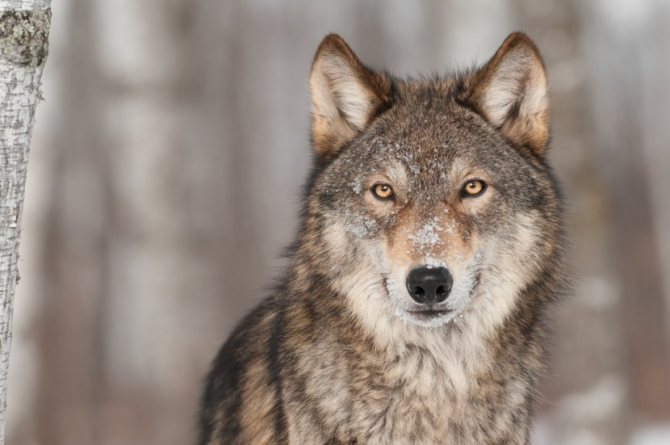

The fur color of the wolf varies in many shades, including gray, white, black, red, and brown. The differences in coloration apply only to the outer layer of the wolf fur, the undercoat of all wolves is always gray.
The complex coloration of wolf fur allows it to blend in with its environment, acting as camouflage, in addition, the mixture of different colors and shades, individual for each animal, allows wolves to distinguish one wolf from another.
The coloration of wolf fur depends on the habitat. Wolves living in forests are often gray-brown in color. Wolves living in the tundra are light, almost white. Wolves living in the desert are grayish-red in color. In the mountains of Central Asia wolves have bright ochre coloration. Arctic wolves are almost entirely white.
Wolves have long and strong legs, with fairly small paws. The front paws are larger than the hind paws and have five toes each. The hind paws have four toes. Wolves have small membranes between their toes that allow them to reduce the specific load of the paw on the surface, so the wolf does not fall through and moves much faster than its victims in deep snow.
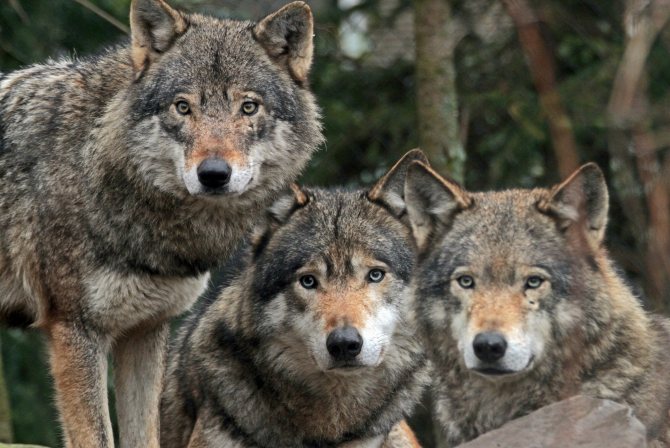

The wolf's paw is designed in such a way that it does not rest on the whole paw, but only on its fingers, which helps it better balance its weight.
The wolf's bristly paw hair and claws help it not to slip when moving on snowy ground.
The wolf's circulatory system is arranged in such a way that the wolf can reduce the flow of blood to its paws to keep its entire body warm.
Between the wolf's toes are scent glands that leave identifying marks behind him that he or other members of his pack can use to navigate the area.
The wolf is a fast and hardy predator. It can trot at a speed of 10 kilometers per hour and run a distance of several kilometers. In one night it can cross 60-80 kilometers, and during the chase it can gallop up to 60 km / h, making jumps of 4-5 meters.
Dimensions
The common gray wolf is quite large for its species. An adult can be up to 160 cm long (we are talking about the length of the body without the tail), the tail - more than half a meter. The height at the withers is quite decent, up to 90 cm. Such height may be compared only with large-breed dogs such as a German Dane, Irish Wolfhound, Newfoundland or Serbernar.
However, all these characteristics are subject to adjustments introduced by the rule formulated by the German biologist Carl Bergmann: the size of an individual depends on the climatic characteristics of the area in which he lives. The lower the annual average temperature, the larger the animal.
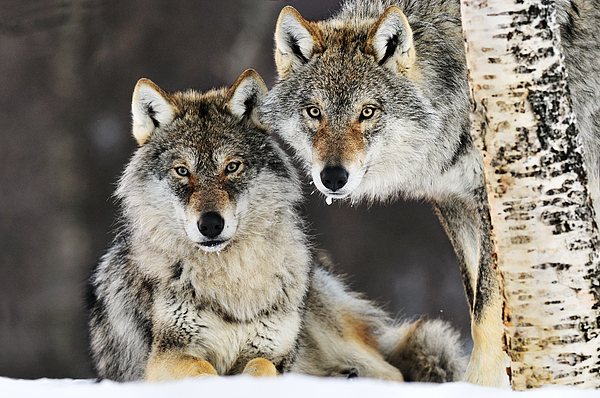

For Alaskan and Siberian wolves, a weight of 77-80 kg is considered normal. And the minimum height of a wolf from the southern areas may be about 60 centimeters with a body length of just over one meter and weighing over 30 kg. The smallest, if I may say so, is considered a subspecies of the Arabian wolf, the weight of some of whose representatives in mature form does not exceed 10 kg.
Wolf tracks
In winter, when moving through deep snow, wolves walk in single file. One wolf follows one another stepping in the trail of the previous wolf. That's why it is not so easy to know how many wolves are in the pack.
The path of wolf's tracks is very straight, looks like a straight line. This is a sure sign that allows you to distinguish the trail of the wolf from the trail of the dog.


The tracks of an adult wolf are 9.5-10.5 cm long and 6-7 cm wide, while those of wolves are much smaller, 8.5-9.5 cm long and 5-6 cm wide.
The wolf holds its paw in a clump, so the imprint of the wolf's footprint is more relief than that of the dog. In addition, the wolf's two middle toes are forward, and the two side toes are backward. If you draw a straight line between the tips of the side toes, the wolf's middle finger bases will go just a little behind that line, but the dog's will have about a third of its middle finger pad behind the line.
The grizzled wolf
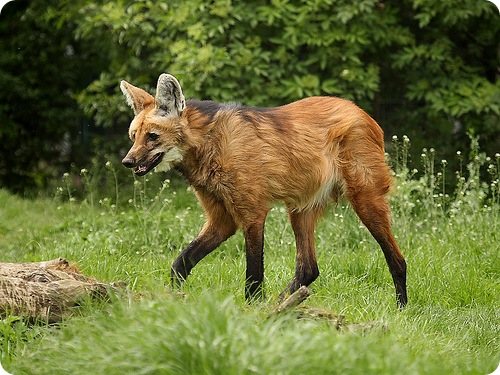

The grubby wolf (Chrysocyon brachyurus) or guara, aguarachai gets its name from the long hair that adorns its shoulders and neck, resembling a horse mane. The griven wolf's habitat is mainly the savannas of South America, but it can also be found in Brazil, Paraguay, Bolivia, Uruguay and Northern Argentina, where it lives in the pampas and along the edges of tall grassy swamps. Lean and light, the maned wolf has a red coat color, an elongated muzzle, and has large ears, which makes it remotely resemble a very large fox. The maned wolf's body length, from the tip of its nose to the tip of its tail, is about 160 cm, the wolf is about 75 cm high at the shoulder, and its weight varies from 20 to 23 kilograms. Aguarachai is the tallest of all known wolf species. Its long legs help the maned wolf locate prey over tall grasses covering savannahs and wetlands. The wolf usually hunts alone, and its prey are mostly small animals such as agoutis, pacu, various birds, and reptiles. It also eats fruit and other plant foods, drags poultry and may attack sheep when gathered in packs. They live in pairs, but rarely come into contact with each other. The grizzly wolf cubs are black in color and are born in winter with 2-3 cubs in a litter. Aguarachai or maned wolves are listed in the International Red Book as endangered. Currently, there is no immediate threat of extinction, but the maned wolf is still a very rare animal.
Wolf howl
The range of sounds produced by wolves is extremely rich and varied. Their vocal capabilities surpass most animals. Wolves howl, howl, grunt, yowl, squeal, growl, bark, and whine. And each sound has a large number of tones.
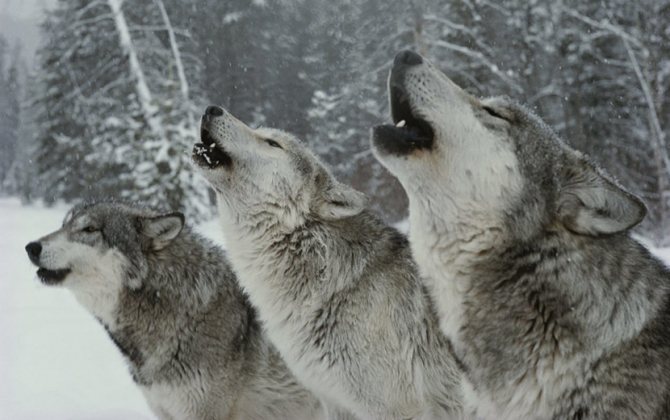

The most well-known to people and heard at a long distance, of the sounds produced by wolves, is the wolf howl.
Wolves howl at dawn or in the late evening hours, but not every day. Wolves start howling in late summer and early fall, most often wolves howl in winter, when they stay in large packs.
Howling is designed for wolves to communicate over a long distance; wolves use howling to find out where members of their pack are, gather the pack before and after hunting, announce the capture of prey, warn rivals from other packs about capturing territory, and look for individuals of the opposite sex.
Wolf howls usually begin with the wolf howling of the pack leader, later other members of the pack join him. Howling of males, wolves, and young wolves is very different from each other. The howl of a wolf pack usually ends with a yapping, shrill bark.
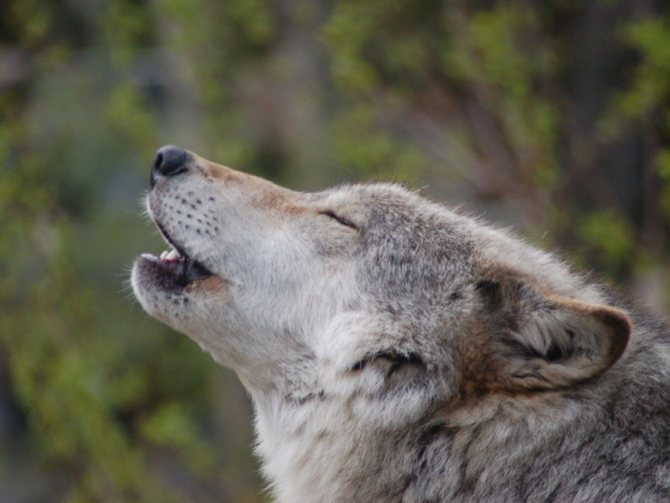

With their howls, wolves can pass even very complicated information to other wolves, such as the presence of prey in a certain place or the appearance of people. In doing so, the wolf first listens to information from another wolf, which may be 8 kilometers away, and then throws its head back and lets out a vibrating howl, first low and then ending on the highest note.
A wolf howl lasts no more than 5 seconds, just because of the echo, the sound seems longer.
Single wolves living outside the pack howl rarely, so as not to endanger themselves.
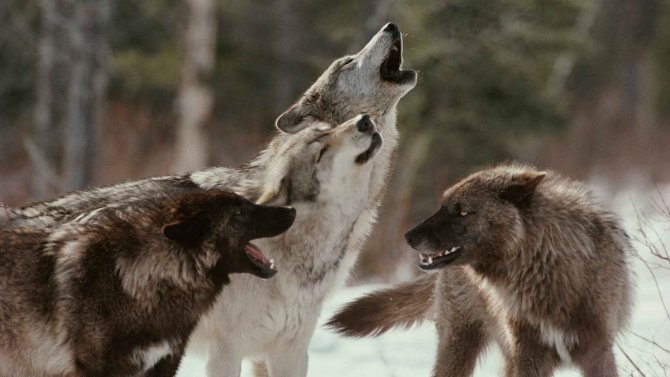

During their hunt, wolves move silently and do not make any sounds so as not to attract the attention of their prey to their presence.
When the pack is ready to attack its prey, the leader of the pack emits a battle cry, which is similar to the growl of an angry dog rushing at a person, this is the signal to the pack to attack the prey.
Some people are not only able to understand the sounds made by wolves, but also know how to skillfully imitate wolves, communicating with wolves by howling.
Types of eye shapes
There are several forms of eyes that differ greatly from each other.
These are:
- Eyes with drooping eyelids - these include Asian-type eyes and eyes that almost all European women are born with. The Asian type is distinguished by the fact that there is no noticeable relief from the eyelashes to the eyebrows. European-type eyes look like age-related skin changes, where the eyes are hidden under an overhanging skin fold;
- eyes that are closely set - the distance between the eyes is less than the volume of the eyes themselves
- eyes that are wide-set - the distance between the eyes is much more than the volume of the eyes themselves
- eyes that have lowered outer corners - the appearance of a kind person;
- eyes that are seated deeply - the space under the eyebrows comes out a bit forward, eyelids are large and mobile, there is a pronounced crease;
- convex eyes - round, large.
To correctly determine the shape of the eyes and their position, you should have patience and a large mirror.
It is recommended to follow the following tips:
It is necessary to look carefully in a mirror in good light (a mirror with a magnifying effect is ideal for this purpose). Look carefully to see if there is a straight crease in the skin on the eyelid (if there is not on the upper eyelid, then the eyes are monolithic, if there is a crease, then you need to look further). Look at the outer corners of the eyes (visually draw a central line through the pupil and the entire eye, look where the corners of the eyes look up or down). If the corners are upwards - the eyes are raised, if downwards - downcast.
To notice a fold, to do this open your eyes wide, look closely and see if the fold is visible or concealed. If it's hidden, then the shape of the woman's eyes is "hooded.
If the fold is visible, you need to look at the last point. It is necessary to study the squirrel coatings of the eyes - if the girl can see the whites on the top and bottom, then her eyes are round, if not - almond-shaped.


Eye shapes: photos and descriptions will help you to determine your own cut and correct it with makeup, if necessary
It is recommended to determine the position of the eyes, relying on the following tips:
look in a large mirror so that each eye can be seen separately; pay attention to the outer corners of the eyes (if the size of the eyes is more than the distance between them, then the eyes are closely planted, if the opposite - widely planted);
Women with large eyes should prefer smoky shades of eye shadow. To "pacify" the eyes, use a black eyeliner on the top line of the eyes. Women with wide set eyes will do well to darken the corners of the eyelid, which is in a fixed position.
Girls with closely set eyes need to lighten between the eyebrows, darken the outer corner of the eyelid, do not paint the inner corner at all. If a member of the fair sex has deep eyes, she should use only warm colors in her makeup and highlight the inner corner of the eye and a little fixed eyelid.
Eye shapes, photos and description of which were presented above, allow you to choose the appropriate type of arrows in the makeup.
- Basic arrows - a short arrow that makes the look more expressive. You need to paint the top with a black pencil, along the lashes, in the corner of the eyes to make a small arrow.
- Arrow with two tails - instead of 1 tail make 2 small ones.
- Classic option - draw the tail first, then a line along the lashes, connect them, each time thickening to the corner of the eyes.
- Half arrow - start drawing the classic arrow from the middle of the eye;
- Wide arrow - to draw further than the usual classic arrow, but also to paint the lashes thicker.
- Arabic version - to paint along the lashes from both sides.
The shape of the eyes can be emphasized with:
- pencil;
- mascara;
- eyeliner;
- highlighter;
- eyeshadow;
- powder;
- foundation.
The design of the article: E. Chaikina
Wolf facial expressions
The mimicry of wolves is also very highly developed: through the position of the mouth, lips, ears and tail, as well as the display of teeth, predators express their emotional state.
Like a domestic dog, a wolf's raised tail and ears signify wariness or aggression.
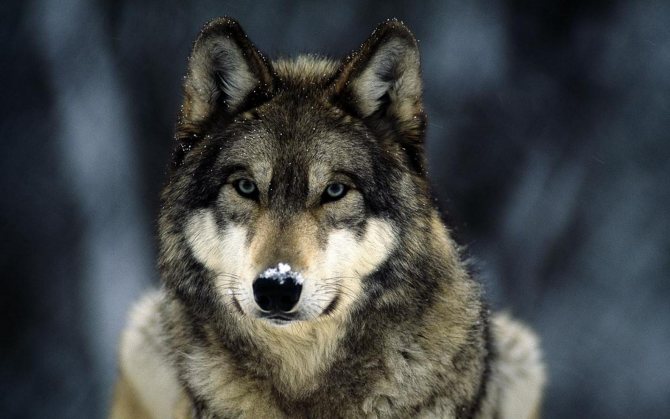

The body language of wolves consists of various expressions of muzzle, tail position.
An aggressive or defensive wolf is characterized by slow and deliberate movements, a high posture and a raised coat; calm wolves have a calm posture, a smooth coat, and lowered ears and tail.
Wolf Eyes.
Wolf has excellent eyesight, and it can't be otherwise, because it's a predator, and its survival depends on how well he sees and how quick he reacts. In addition, the animal is most active at night - therefore, it has excellent twilight vision.
It is still unclear whether wolves are color-blind, although the tab flags when hunting these animals are traditionally made red.
All wolf cubs, like most mammals, are born blind. When babies' eyes begin to open, they are blue in color. But in just 2 to 4 months, the iris color will change and become the usual color for this animal, golden yellow or darker - yellow-brown. The hue and saturation of the color depends on the overall color of the animal. It is believed that the darker the color of the wolf's coat, the lighter and brighter the eyes. However, very rarely, but there were cases when a wolf remained with blue eyes.
Nevertheless, to the traditional question of what color eyes a wolf has, most would not hesitate to answer: yellow. Such a color, generally speaking, is common among animals. An iris of the same or similar color is found in cats, foxes, owls, eagles, pigeons, and fish. The lipochrome pigment, which is present in the iris, is responsible for this coloring.
As for the romantic image of a white wolf with blue eyes, we are not talking about a wolf, but about a husky. This breed (Siberian Husky) was bred by northern peoples from the aboriginal ancient sled dogs.
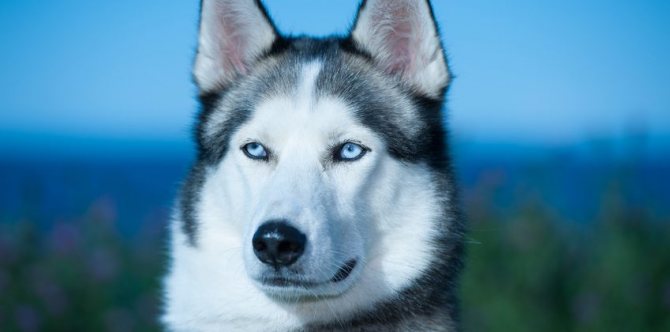

Its eyes, according to the breed, can be not only brown, amber and green, but also blue. And the color of fur can range from pure white (which is actually rare) to white-gray, wolfish. There are also black huskies.
Sense organs of the wolf
Of the sense organs of the wolf is the best developed sense of smell, the second place is hearing, and in last place sight.
Recent studies show the enormous importance of sense of smell in wolf, when observing wolf packs, 82% of wolves detected moose by smell and only 18% by hearing.
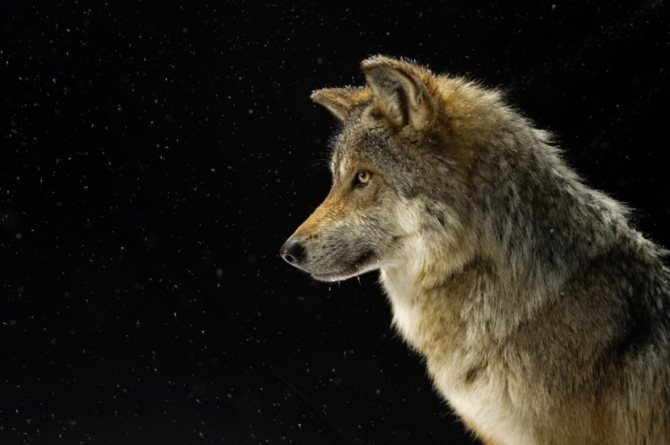

The wolf has an amazing sense of smell, which is 100 times better than that of humans. A wolf can detect its prey at a distance of three kilometers. Wolves can distinguish 200 million types of odors, compared to only 5 million for humans. It is through the sense of smell that the wolf gets most of its information about the world around it.
Urine and fecal marks play a big role in wolf's life. With these tags, the wolf transmits and receives information about the species and sex of the animal that left the tag.
Hearing also plays a big role in wolf life. Wolves are able to hear sounds at a distance of 9 kilometers in the woods and up to 16 kilometers in open terrain.
Interesting facts about the color of human eyes
An interesting scientific fact is that humans actually see with their brains, not their eyes. The incoming light radiation through the nerve cells is transmitted to the brain, which analyzes it and gives the information received in the familiar form of a picture.
It is worth noting that the color of the eyes has no effect on the quality of the received "picture" from the brain. Therefore, when there are problems with vision, mainly the disorder lies in the work of the brain.
Other interesting facts about eye color are:
- Previously (about 10 thousand years ago), all the inhabitants of the planet had brown eyes. As a result of a mutation process (there was a decrease in melanin levels), there was a blue eye shade.
- There are 16 different eye shades in various combinations of blue, gray, green, yellow and black.
- One of the rarest occurrences are considered red eyes, which are a consequence of albinism (a hereditary disease characterized by an absence of melanin in the body). Blood can be seen through the transparent vessels of the iris, which is devoid of pigment, so the eyes have a red tint.
- The color and pattern of each person's iris is as individual as a fingerprint. Therefore, it can be used to identify a person's identity.
- Brown eyes, according to ophthalmologists, are actually blue - they are just hidden under the brown pigment. Such a phenomenon is also the result of a genetic mutation.
Yellow eyes in the absence of eye disease are an individual characteristic of a person, as are eyes of other shades. They are extremely rare and make a person's gaze resemble that of a wolf's gaze, which is noticeable even in photographs.
Range
The wolf is the most common terrestrial predator. Historically, the wolf's range was the second largest after that of humans. Nowadays, the wolf's range and its total population has significantly decreased, the main reason for this is human activities: changes in the natural environment, the development of cities and the extermination of wolves as a result of wolf hunting.
In many parts of the world, the wolf is on the verge of extinction, but there are still many wolves in northern Eurasia and America.
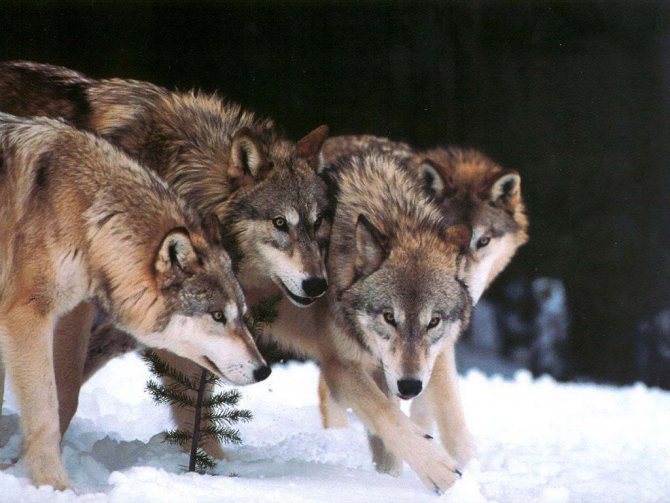

In Europe, the wolf is found in Spain, Portugal, Italy, the Baltic countries, Russia, Belarus, Poland, the Scandinavian countries, the Balkans, and Ukraine.
In Asia wolves inhabit Korea, parts of China and India, the Caucasus, Kazakhstan, Kyrgyzstan, Afghanistan, Iran, Iraq, and the northern Arabian Peninsula.
Throughout North America, from Alaska to Mexico. In Africa, wolves are found in Ethiopia. In South America: in Brazil, Bolivia, and Paraguay.
By number, most wolves in Russia - 70 thousand, in Canada and Alaska - 50 thousand, in the U.S. territory - 6500 wolves, in Spain - 2000 wolves, in Poland - 700 wolves, in Italy - 300 wolves, in Norway and Sweden - about 80.
Melville island wolf
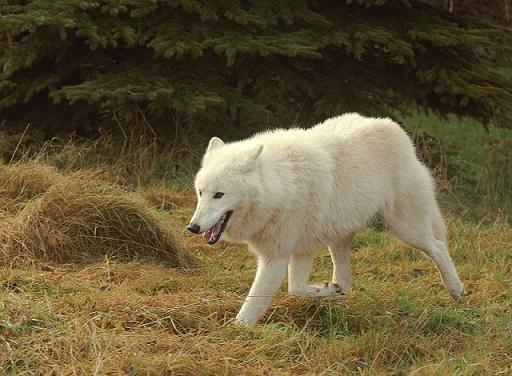

Melville island wolf (Canis lupus arctos), also called the ellsmere or arctic wolf, lives in North America on a group of Arctic islands and in the northern part of the island of Greenland. The Melville island wolf is slightly smaller in size than the common wolf, and its length, from its ears to the tip of its tail, varies from 90 to 180 cm. In height, the wolf reaches a maximum of 69-79 cm, weighing about 45 kg, although particularly large, adult males can weigh about 80 kg. The fur of the Melville Island wolf is usually light white or grayish. The wolf's ears are small in size, which helps him consume heat rationally in low temperatures. In order to hunt more successfully, Melville wolves band in packs of 5 to 10 individuals. The main targets of the Melville island wolf are reindeer and musk oxen, to which the wolf pack applies corral hunting tactics, attacking mostly weakened prey that cannot offer strong resistance. Arctic hares, lemmings and, sometimes, elk are also the wolf's food. Permafrost is a significant obstacle, making it difficult for wolves to establish and dig a den, so wolves use the natural landscape and place their dwellings in rock ledges, caves, or small hollows. The number of cubs born by the Melville Island wolf is small, 2-3 per litter, largely due to the harsh living conditions in the Arctic climate.
Habitats
Wolves inhabit a variety of natural areas: tundra, forest-tundra, steppe, forest-steppe, and semi-deserts, avoiding dense forests. Can settle in the mountains, from the foothills to the alpine meadow zone. The wolf can settle close to human habitation. In the taiga, the wolf spread following humans as the taiga forests were cut down.


Wolves make dens to breed and most often use natural shelters: crevices in rocks, bushes, overgrown ravines. Wolves may occupy burrows of badgers, marmots, foxes and other animals. Wolves themselves dig dens very rarely. The female wolf is tied to the den most of all during the rearing of wolf cubs; the male wolf is not tied to the den. As soon as the cubs grow up, wolves stop using the den. Wolves never hunt near their den, but hunt at least 7-10 km away from it.
Crow's eye berries
Crow's eye berries of the four-leafed crow's-eye fully mature in late summer. They are up to ten millimeters in diameter, black with a bluish patina, similar to the fruits of blueberries and bilberries. There are many seeds inside. The berries have an unpleasant taste and their mere smell can cause nausea and headaches in humans. Animals avoid these berries and never eat them, but birds, on the contrary, eat crow's-eye fruits with pleasure. It is necessary to know the distinctive features of the crows-eye herb in order to avoid poisoning by the fruit, which is very toxic.
In medical practice, three kinds of crow's eye are most commonly used:
- four-leaf
- incomplete
- Multi-leaf .
Chemical Composition
The berries and other parts of crow's eye contain very dangerous poisonous substances:
- paradin
- paraffin .
The greatest amount of them are in the composition of the fruit and underground roots of the plant. Less toxic are the leaves.
In addition there are: - flavonoids - coumarins - pectins - steroids - alkaloids - vitamin C - saponins - glycosides These substances are absolutely harmless to humans. In the right doses, the plant can be used to treat certain diseases.


Wolf Pack
The wolf is a social animal and lives in packs. A wolf pack is a family group of wolves that includes animals of different sexes and ages. A wolf pack can consist of 3 to 40 wolves. The pack is led by the pack leader, which is a mature wolf, the dominant alpha male. Leader of the pack has unquestionable authority, it's the most intelligent, experienced and strongest male in the entire pack. The leader is friendly to members of his pack, but extremely aggressive to outsiders. The leader's mate is the alpha female. The other members of the pack are the offspring of the main pair, their relatives, and lone wolves that have strayed into the pack.
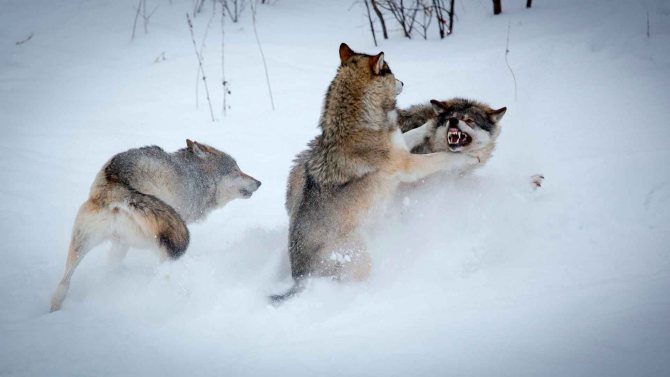

There is often a beta male in the pack, a wolf ready to replace the pack leader. Most often it is either the alpha male's son or his brother. The beta male occasionally shows aggression towards the pack leader, showing that he is ready to replace him at any time.
Each wolf pack has its own territory, its own hunting area, which it carefully guards from other wolves and hunts only in it.
Wolves mark the borders of their territory with scent marks, as well as by leaving scratches with their claws on fallen trees and old stumps. As they move through their territory, the pack leader leaves scent marks every 3 minutes. There are especially many marks on the border of the territory. The wolf pack marks its territory by howling.
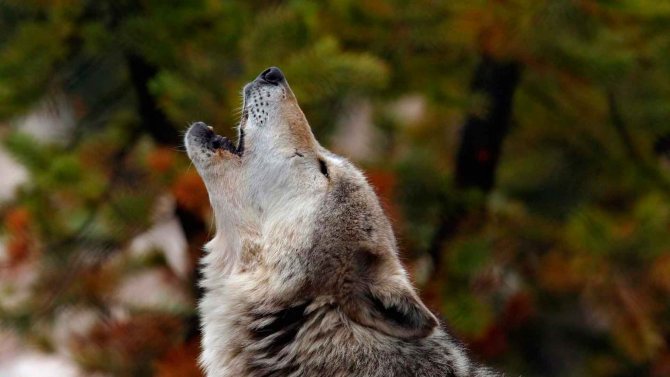

The territory size occupied by a wolf pack can be from 50 to 1500 square kilometers. On the open spaces of tundra and steppe wolf hunting area is 1000-1250 square kilometers, in the forest zone its size is much smaller 200-250 square kilometers.
Wolves gather in packs only in winter, as soon as spring comes, the wolf pack disintegrates, the territory is divided into several areas, the best of which goes to the dominant pair, the rest of the wolves switch to a semi-walking lifestyle.
Medicinal properties of the plant
Crow's eye is a strong plant poison, its use in traditional medicine is not allowed. And in folk medicine it is used, but with extreme caution. Raw material for medicinal use is better to procure during the flowering period. Crow's eye is used for medicinal purposes in its entirety, from the leaves and stems prepare an alcoholic tincture.
The green part is cut off at the root. This should always be done with gloves on. The fruits are collected after they ripen. Use them fresh and dried. Prepare infusions and decoctions.
Crow's eye four-leaf has the following properties:
- soothing
- antispasmodic
- diuretic
- anti-inflammatory
The leaves as well as the berries of the plant have a vomiting and laxative effect. Decoction of the plant is able to relieve cramps, helps with severe fever and dropsy. Berry alcohol tinctures are used to treat inflammation of the throat, migraine, increased sleepiness, and heart disease.
Crow's eye serves as an effective medicine for the following diseases:
- for tachycardia
- arrhythmia
- sore throat
- laryngitis
- tuberculosis
- bronchitis
- neuralgia
- endocrine disorders
- swellings
- hearing problems
In addition, the correct use of preparations of this plant is able to improve appetite and intestinal function.
Very widely the plant is used in homeopathic medicine to get rid of nervous tics, mental disorders, conjunctivitis, frequent inflammation of the throat. Treatment should be under the full supervision of a homeopathic physician.
In official traditional medicine, this plant is considered poisonous and its use for the preparation of any medicines is officially prohibited.


What a wolf eats
Wolf is a predator that gets its food by actively looking for and stalking its prey. The wolf's main diet consists of large ungulate animals: in the tundra - reindeer, in the forest zone - elk, wild boar, deer, roe deer, in the steppes and deserts - antelope, saiga, sheep, goats. Sometimes large ungulates hunted by wolves are 10-15 times larger than the wolf itself.
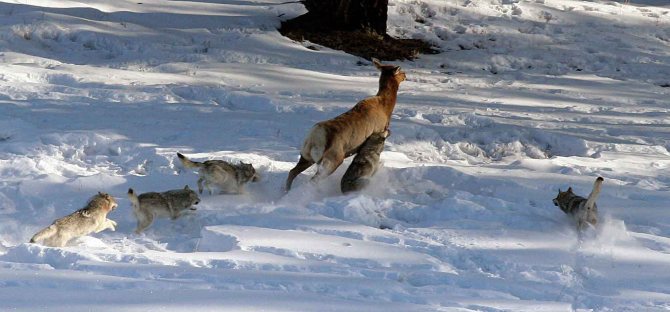

Wolves have always been attracted to large concentrations of livestock and can often be found near farms or near grazing areas. In such places, sheep, cows and horses can become wolf victims. When attacking a herd, wolves often slaughter several animals at once; they eat some of the meat at once and leave the rest in reserve.
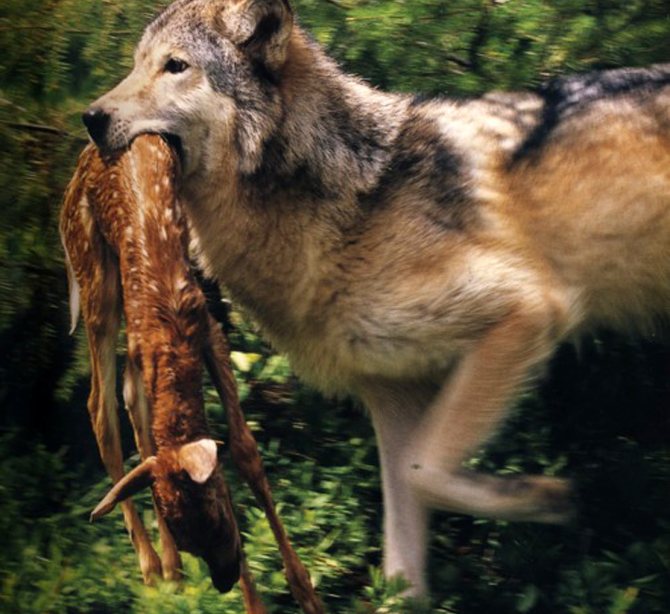

Despite the close kinship between the wolf and the dog, the latter often become the wolf's prey; sometimes wandering dogs become the main food for wolves at all.
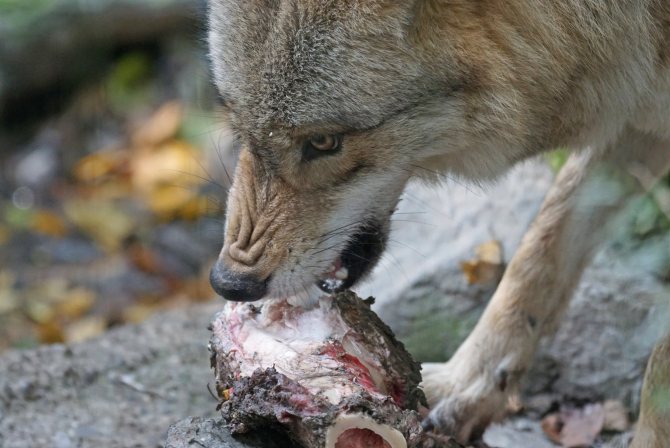

Solitary wolves often hunt smaller prey: hares, gophers, small rodents. The wolf will not miss an opportunity to eat a clutch of eggs, chicks in the nest, birds feeding on the ground.
Sometimes wolves prey on other predatory animals: foxes, raccoon dogs, corsacs. A pack of hungry wolves can even attack a bear sleeping in a den.
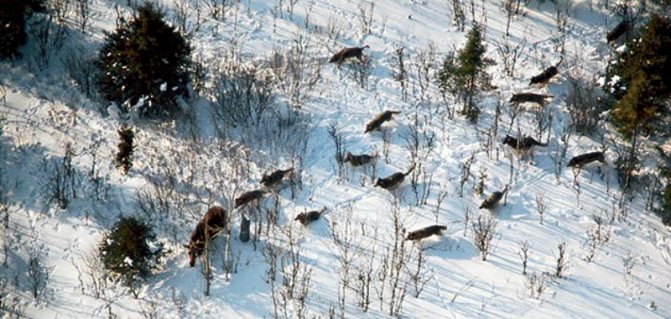

A hungry wolf pack can attack its weak or wounded relatives. Hunters know that they must take a trapped wolf as quickly as possible, otherwise other wolves will find him and eat him.
When there is no food, wolves eat reptiles, frogs and even large insects. In southern areas wolves may eat plant food: berries, fruits, mushrooms, and make forays into melon and watermelon fields.
Wolves often return to the uneaten remains of their prey, especially during the hungry season, and may eat carcasses or corpses of livestock.


On average, a wolf needs 3-4.5 kilograms of meat a day, but it is not possible to get its own food every day; wolves can go without food for up to two weeks. When a wolf pack manages to get a big prey, it has enough food and it can eat up to 10 kilometers of meat at a time. By comparison, it is as if a person ate 100 hamburgers at one time.
Wolf Eyes.
The hunter himself is usually a brave man, and if he is also holding a gun, courage is doubled. But it's all within the confines of his own home.
When you find yourself in the woods at night, even two guns on your shoulder doesn't add to your courage. I judge by my own experience.
This story didn't happen that long ago, and the fear hasn't cooled off yet.
The place of my work on catching and preparing fish for transportation, was at the mouth of a small river flowing into the bay of Natalia.
My colleagues were just like me, shabashnikovs, who had come for the season for the "long ruble.
I did not want to look at fish anymore, red caviar was still nauseating, stew was also boring, so any other food was a blessing, even with dried potatoes and onions.
But it was not so easy to catch a beast or a bird for the weak in the field of hunting, in spite of the presence in the brigade of the kurkovka of the 12th caliber, and it is unclear what kind of shot loaded papkas cartridges, crookedly twisted by the star, the more they shot through once, often leaving the back of the cartridge in the barrel.
Sometimes I managed to sneak up on a flock of diving ducks and get two or three, and on rare occasions, I managed to get a couple of partridges.
From such luck, I was recognized as the most experienced hunter, and I was sent to nature's "stores" for meat provisions more often than anyone else.
Our "watcher" gave everyone a chilling look in his pants about the presence of hungry wolves and bears roaming around, and advised us not to go more than a kilometer from the barracks.
Fearing the bloodthirsty beasts, everyone obeyed the chief's advice without question.
On one of my hikes, I did stray beyond the supposed line of demarcation, and in the bushes along a small stream, I got two hares, though I missed three more. It turned out, the farther from the camp - the more whites.
Our feast was excellent! I was unanimously acknowledged the chief hunter of the area with all the responsibilities that this entails.
On another hunting day, Mikhail, a boy from Buryatia, who had just returned from compulsory military service in the spring, was given to me as an assistant. Misha served in the construction battalion and had nothing in his hands but a shovel. He took even a rifle with great apprehension.
The two of us were not so scary, and I intended to stock up on game for a long time, mastering the far reaches.
The bushy creek went into the tundra, hiding behind the horizon and looping, making half-circles and other turns.
The first hare jumped out a little far and after the shot - waddled away. Two of us chased it and for the safety of ammunition, I was not going to finish it.
We managed to catch it in about forty minutes. Michael pressed it with his body, having fallen from loss of strength, so I had to lift them both.
Barely out of breath, we moved on.
Two hares rushed out of a small hole, the first was killed, and the story was repeated with the second. The hare did not let us to itself, but also very quickly did not run away.
About twenty minutes later, with a heavy heart, we still had to finish him off with a shot.
After a small break, having looked round, I asked:
- "Misha, do you remember where we came from?"
From the strangely stretched out face of Mikhail it became clear that we both had no idea about the direction to the "house".
I will note that it was a day without wind and sun, with black clouds overhead, just a beautiful day, but there was no time to feel it.
At first I joked that we were in a clear field, i.e. the tundra, but we were lost.
When we began to realize that the day was not eternal and it was close to its end, we did not want to joke, and remembering the warning about the presence of hungry wolves and bears in the area we became sad.
Carefully I counted three remained cartridges in my pocket - yes, it would be difficult to pass the night, especially if I had to beat off the beasts. What professional hunters do in such situations, I had no idea.
We decided to go a little more, and the rest of day time to prepare for lodging, i.e. to collect plenty of dry branches, which we can't find in tundra, and the next day, after possible sunrise - to clear up where to go.
And so we acted.
As soon as it began to get dark we started our work. We picked up everything we could - dry grass, branches, and even pulled the roots of dwarf trees.
Finally, having made a large stack, and completely tired, we lay down by a small fire in the hope that if we save money, we would last until morning, as long as it did not rain.
We had a reminiscence dinner, but Misha refused to sleep, having said that he will be on duty in case of an animal attack. I took off shoes, spread baize plaits on twigs to dry, and, having embraced the gun, covered my eyes to the sound of my colleague's muttering.
I was awakened by Mikhail's incredible scream.
The fire showed no signs of life, and judging by the stomping and shouting, my night watchman and fellow hunter was running away into the darkness from the fire.
My first thought was, was a bear carrying him away?
My hair stood on end and I shouted into the darkness:
- "Where are you going? What happened?"
After a minute, Mikhail answered and called me to him.
It stood on a small hill from which we could see a faint light - it was the window of our barracks, where under the light of a kerosene lamp, the colleagues were discussing a plan to find two unfortunate meat cullers. We had not reached only fifty meters to see where we lived.
So what had happened to Mikhail?
The young body was unable to overcome sleep, and when my slippers, burned in the center, left only a couple of sparks around the edges, Mikhail woke up.
Right in front of him he saw the black face of a huge wolf with brightly burning eyes.
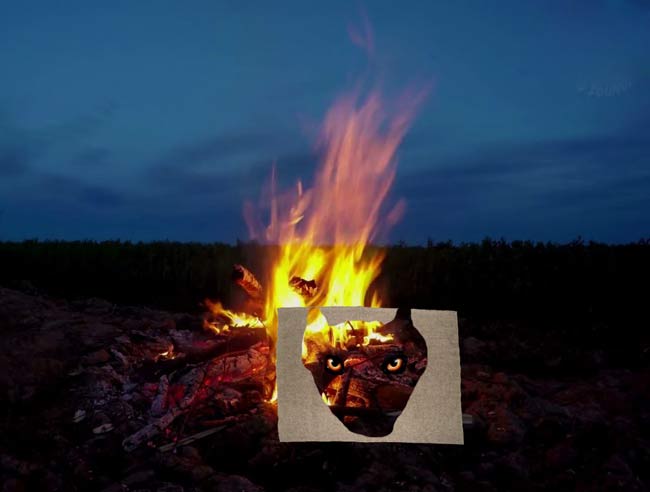

In an instant his legs threw the young body and carried him away from the fierce beast with a shriek.
I must pay tribute that running up the hill, he remembered that he was not alone, and looking around, probably hoping to find a tree - he saw our camp.
Having told everything to the guys, we laughed a very long time, discussing all the details, but Mikhail has not gone hunting since then. Not everyone can survive such a thing.
But with his ability to run in the tundra, he doesn't need a gun, the main thing is to scare him.
Artur Polyakov
Guest article from his personal site
How wolves hunt
The wolf is one of the strongest, toughest and most cunning predators, which can track and relentlessly pursue its prey.
Wolves can hunt both in packs and individually. In winter, wolves hunt in packs of large ungulates. A wolf can easily move through snow cover, while large ungulates find it much harder to move through snow and evade wolf chases.
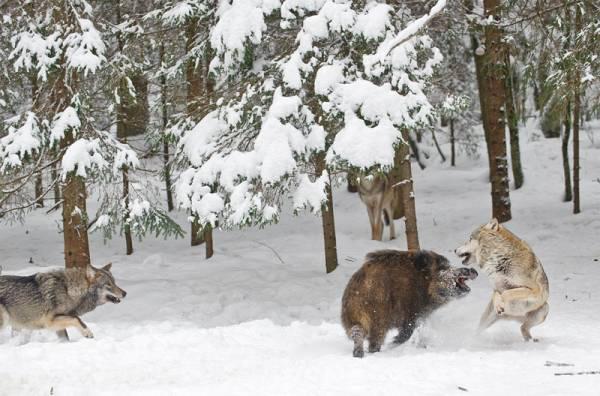

Most wolves attack young, old, sick or wounded animals, and they sense which animals are strong and healthy, and which are sick or weakened.
When wolves hunt in packs, each wolf has its own role in the hunt, some wolves participate in the pursuit of prey and another part of the wolf pack cuts the prey off. When hunting, the wolf primarily uses its sense of smell. Gut tells a wolf where its prey is, and wolves use their gut to follow its prey along its tracks.
When hunting in packs, wolves kill their prey by attacking as a pack, with the leader and his female wolf having the right to eat the prey first, they get the best parts of the prey's carcass.
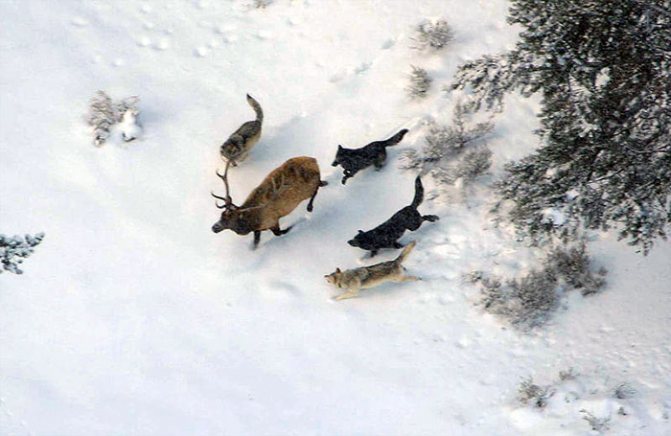

Wolves are very cunning animals, sometimes they feel that they can not catch up with their prey, and when the prey gets away from them and slow down, wolves attack again. When wolves attack a herd of livestock, the wolf pack divides, some wolves attack the dogs guarding the herd and the rest of the wolves attack the herd itself. Wolves are able to use areas they know well to drive their victims into a dead end and finish them off there. Often a pack of wolves secretly follows a herd of ungulates for a long time, waiting for the right moment to attack.
The wolf's main weapon is its teeth, the wolf's sharp fangs reach a length of 5 cm, with which the wolf holds, kills and drags its prey. The teeth are so important to the wolf that the loss of teeth is fatal for him.


In summer, the pack splits up and wolves hunt alone. The main summer prey of the wolf is hares. In addition to hares, wolf hunts rodents in summer. He jumps on a rodent from above, paws it and eats it. A wolf, when hunting alone, behaves very cautiously. He can sit in an ambush for hours, waiting for his prey. Stealthily sneaking up on his prey, the wolf swiftly grabs it by the throat, dropping it on the ground and killing it.
Red wolf
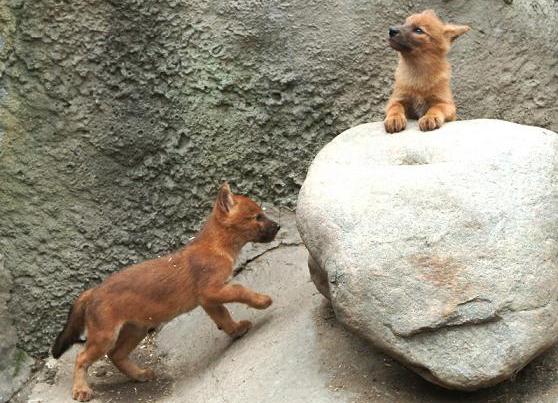

Red wolf - A rare species listed in the IUCN Red List and the Red Book of the Russian Federation. On the territory of Russia it is under the threat of extinction. In India, it is allowed to hunt, but only with a license. Externally, this animal has a peculiar appearance - a mixture of features of the gray wolf, fox and jackal. The body length is 76-103 cm, the tail 40-48 cm, and the weight is 14-21 kg. The red wolf has a thick, long reddish-red coat on the back and sides, and cream-colored on the chest, abdomen, and inside of the legs. The long fluffy tail is fox-like, darker than the rest of the body, almost black at the end. The head shows a dark pattern around the eyes and on the nose. The red wolf is a predator and eats mostly wild animals, but in the summer it also eats plant foods, namely mountain rhubarb. This plant is always found in lairs with pups. Wolves are believed to feed them to young wolves by regurgitating semi-digested rhubarb inflorescences. Sometimes they eat carrion. Wolves hunt in packs of 15-20 wolves and act in a very well-coordinated manner that allows them to capture even a large animal, such as a buffalo. Thanks to their endurance, they drive their prey to the point of exhaustion, after which its fate is sealed. Red wolves are quite "talkative" animals. The awake animals emit quiet whimpers almost constantly, apparently to keep in touch with other members of the pack. In India, red colts breed within six months. Females are 60-68 days pregnant. The average brood size is 4-6 pups. The cubs are dark brown in color, blind, weighing 200-350 g. They leave the den at 70-80 days old and at seven months already take part in collective hunting. Puberty begins at 2-3 years of age. Longevity in captivity is about 16 years. In captivity, this period is much less.
Wolf reproduction
Wolves are monogamous, pairs are formed for life until one of the wolves dies, there is one female per male. Wolves live in packs, with an alpha male and an alpha female at the head of the pack. When the pups grow up, they don't mate with each other, their instinct makes them look for a mate outside the pack.
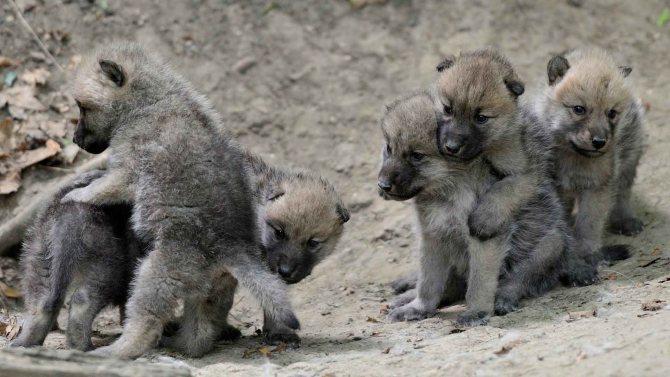

With the onset of the mating season, which takes place from January to April, tensions rise in the wolf pack. The male and female of the main pair aggressively guard each other from other members of the pack. A group of wolves gathers around the rest of the lone female wolf pack, between which fights occur, sometimes with a fatal outcome. Once a new pair is formed, they look for a territory where they can breed.
In a season, a wolf pack breeds only one offspring, with the parents of the wolves being a pair of leaders.
A wolf's pregnancy lasts 62-65 days and she gives birth to 3 to 13 wolf cubs. At birth, the cubs weigh 300-500 grams and are covered with short, soft grayish-brown fur; newborn wolf cubs have blue eyes. Newborn wolf cubs are born blind and deaf. They regain their sight and hear only on the 12th-13th day. During the first month, the cubs suck wolf's milk, the wolves feed them with a burp of half-digested meat they have eaten, and when the cubs become even older they are fed with killed prey. The whole pack takes part in the rearing of the wolf cubs; the wolves bring the best meat to the cubs. During the first four months of their lives, the cubs grow very quickly, their weight increasing more than 30 times during this time. Though wolves are very caring and attentive to their young, up to 60-80% of cubs die in the first year of life.
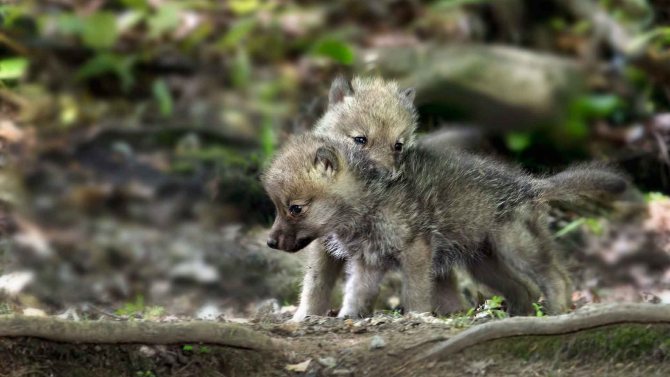

At the age of 2 months, wolf cubs leave the den, but still stick around. At this time, they begin learning to hunt by attacking shrews and mice. At 8 months of age, the color of the wolf cubs' eyes changes from blue to yellow.
By the end of summer, young wolves begin to hunt with the adults. At the same time, the cubs born the previous year and driven away for the time of breeding and bringing up young wolves join the pack.
By the end of the first winter, the cubs reach the size of an adult wolf.
The wolf pack stays in such composition until the new breeding cycle. In autumn and winter, a typical wolf pack consists of two wolves of the main pair, 3-6 yearlings (wolves of this year of birth), 2-4 pairs (wolves of the previous year of birth), so the total number of wolves in the pack is 7-12 individuals.
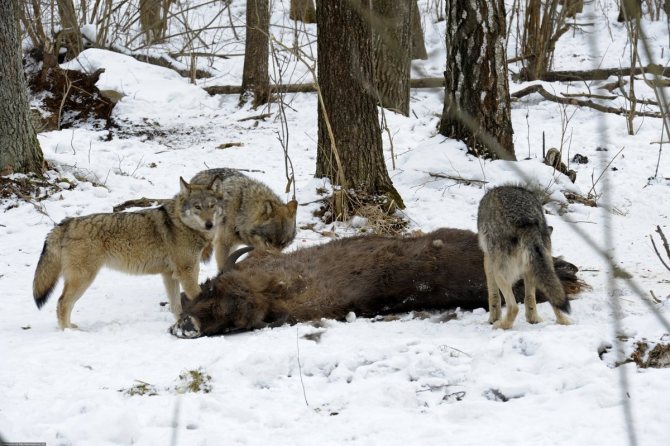

The maximal life span of a wolf is 12-15 years.
Types of eye shapes
There are several eye shapes that differ greatly from each other.
These are:
- Eyes with overhanging eyelids - these include the Asian type eyes and the eyes with which almost all European women are born. The Asian type is characterized by the fact that from the eyelashes to the eyebrows there is no noticeable relief. European-type eyes look like age-related skin changes, where the eyes are hidden under an overhanging skin fold;
- eyes that are close-set - the distance between the eyes is less than the volume of the eyes themselves
- eyes that are wide-set - the distance between the eyes is much more than the volume of the eyes themselves;
- eyes that have lowered outer corners - the appearance of a kind person;
- deep-set eyes - the space under the eyebrows extends slightly forward, the eyelids are large and mobile, and there is a pronounced crease;
- convex eyes - round, large.
Enemies of the wolf in the wild
The wolf is a strong and intelligent predator, and it has few enemies in nature. The wolf may clash with another predator: a bear or a lynx over prey. Sometimes a wolf is seriously injured when hunting large ungulates: elk, wild boar, deer or bison; sometimes a wolf even dies from its injuries or inability to hunt.
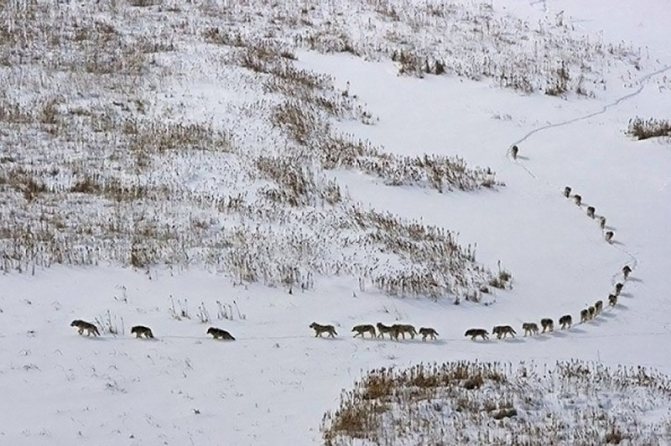

It sometimes happens that two wolf packs share territory and stage bloody fights among themselves, which sometimes even lead to the death of a wolf from one of the packs. The main enemy of the wolf is man. Wolves are detrimental to livestock production, and because of this man has been fighting wolves for a long time, setting traps and shooting wolves. All this leads to a tangible decrease in the wolf population.
Japanese Wolf


Japanese wolf Is a member of the class of mammals and is a member of the class of carnivores. The name "Japanese wolf" came from two subspecies of the wolf family Canis lupus, which used to inhabit the islands of Japan. In the world classification, the Japanese wolf refers to the Hokkaido wolf (Canis lupus hattai). It is also known as the Ezo, a wolf that lived on the island of Hokkaido. And the second subspecies is the Hondo wolf or Honshu wolf (Canis lupus hodophilax). Today, both species are considered extinct. The Hokkaido wolf was much larger than the Honshu wolf in terms of its external size, and in terms of parameters approaching the size of the common wolf. In 1889 the subspecies became extinct due to increased settlement of the island for building farms during the Meiji Restoration, the Meiji government set a reward for anyone who brought a dead wolf's head, thus organizing a campaign to eradicate them.
Wolf Hunting.
The wolf causes serious damage to both livestock and hunting. To estimate the scale of damage caused by wolves, it is enough to note that in Yakutia alone in 2012 wolves killed about 800 domestic reindeer and more than 200 horses. The damage caused by wolves to livestock has always been the main reason for hunting the gray predator. We should not forget that the wolf performs an important function in the ecosystem, controlling the number of some species of animals, as well as destroying weak and sick individuals. Mass and unrestricted hunting of wolves can pose a serious threat to the wolf population.
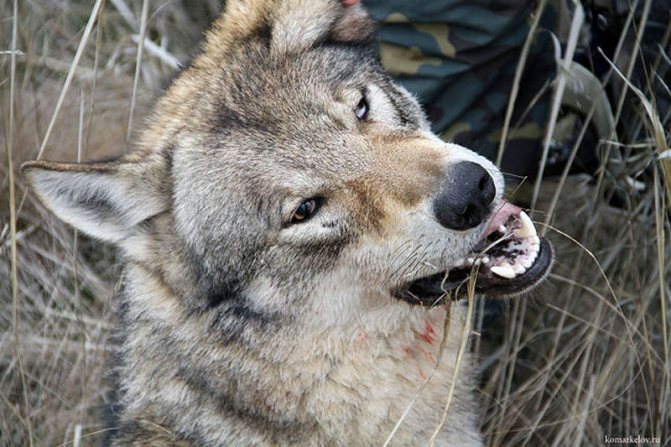

Until recently, wolf hunting in Russia was allowed year-round. Currently, in most regions, wolf hunting is allowed from October 1 to February 28. At other times, it is forbidden to hunt the grey predator.
Hunting wolves is not easy enough, because of wolf's highly developed senses, cunning and caution.
Meat of wolves is not eaten, the trophy is a wolf skin, which is most often used to decorate the room as a floor or wall rug.
The structure of the macula of the eye
The yellow spot coincides with the central zone of the retina. The macula is about 5.5 mm in diameter. In the very center of the yellow spot there is a depression (fossa), which is about 1.5 mm in size.
Due to the fact that the macular zone contains a large amount of a special pigment whose color is yellow, this area is colored yellow by ophthalmoscopy. This is the reason why the macula gets its second name. The main pigments contained in the yellow spot are lutein and zeaxanthin. The human body is not able to synthesize these substances on its own, so all pigment reserves come from outside (with food, drugs). A lot of lutein and zeaxanthin are contained in products of green, orange and yellow colors. The main role of pigments is to protect the photoreceptors of the retina from reactive oxygen species and other free radicals. The latter are formed as a result of oxidative reactions and negatively affect nerve cells and the eyeball.
Interestingly, there are no blood vessels in the yellow spot, so the nutrition comes from the adjacent chorioidea (vasculature).


Wolf attacks on humans
There are different opinions about the danger of wolves to humans. In most cases, rabies-infected wolves attack humans. Unlike other animals, such as foxes and dogs, which go into lethargy and become disoriented when infected, wolves instantly go into a rage when infected. When attacking a person or other victim, wolves tend to bite their neck or head, which causes the rabies virus to enter the human brain much faster, much sooner than medical attention can be given.


In addition to cases of wolf attacks due to rabies, there have been many cases of perfectly healthy wolves attacking humans.
Some researchers conclude that wolves behave aggressively and even attack humans in places where wolves lack natural prey, in such places wolves feed at the expense of humans and are less afraid of him. It has also been suggested that wolf attacks on people occur in the summer, when wolves need to feed the younger generation, as well as a high density of wolves in the grounds.
The magic of the gaze
For most people, the direct fixed gaze of a large animal directed at them is perceived as a threat. This is most likely due to ancient perceptions, when human survival depended solely on the reaction and speed of running. Even today, the wolf is considered a dangerous and formidable predator, and an encounter with it in a deserted place and without weapons is fraught with the worst complications. Although it is believed that wolf aggression is rarely aimed directly at humans.
The well-developed eyebrows make a wolf's eyes deeply set and its gaze squinted. This, too, does not add to a person's presence of mind. It is not for nothing that in medieval Christian concepts the wolf was considered an accomplice of the devil, and his appearance was an expression of heresy, cunning and malice.
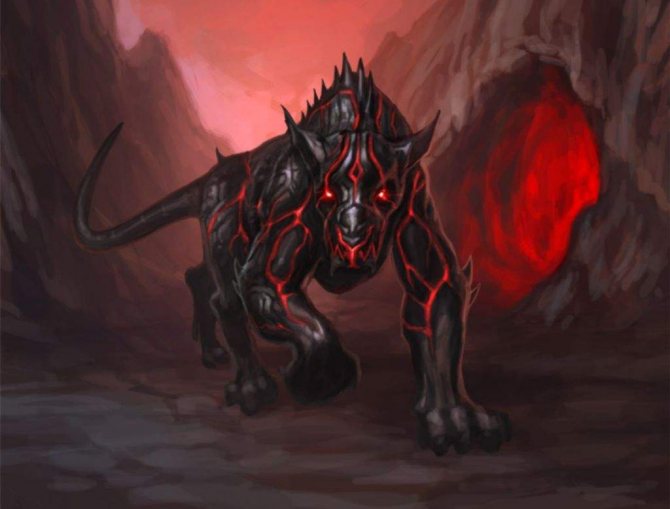

The image of the "infernal" wolf stealing souls with eyes that burn with fire was highlighted by philologist and historian Jacob Grimm in his work "German Mythology". These were the mythological concepts of the ancient Germans. A researcher of Slavic folklore Afanasiev spoke about this demonic image, mentioning the proverbs:
A word would have been said, but the wolf is not far away.
Man-werewolf, werewolf, werewolf and lycanthrope also came to modern art from mythology.
How Wolves Share Territory
Owning a vast territory, a pack of e.g. polar wolves, of course, can not keep exclusive rights to it, but wolves living in the forest, whose possessions are much smaller, are forced to clearly understand the boundaries of their territory. Wolves mark their territory with the smell of their own body, raising their paw as well as domestic dogs. They do it especially carefully on the border with the territory of another pack, so that neighbors would understand who they are dealing with and would be afraid to break the border. Smells play an even greater role in communication between wolves than sounds. If one pack of wolves, for example during hunting season, crosses with another pack, bloody fights with victims are inevitable, so the wolves howl warning others of their whereabouts. The alpha male usually starts with a howl, his howl is picked up by others... In pursuit of prey, wolves howl with shorter sounds, alerting their fellows where they are. All nearby wolf packs respond to the howling of one of the packs, and immediately an unthinkable forest cacophony begins. However, it often happens that one of the pack reasonably does not pick up someone else's howl, it is numerically too small, and therefore it needs to hide or retreat as quickly as possible for the same reasons. It should be noted that a lone wolf will never howl.
Click here to hide the text
Makenzen Wolf


The Mackenzie Wolf. - Also known as the Mountain Wolf, the Alaskan or Canadian timber wolf. A direct relative of our forest wolf, but because of its specific habitat conditions, it has a thicker coat and whitish coloration that remains even in summer.
Tundra wolf, Middle Russian forest wolf, Siberian forest wolf, Steppe wolf, Caucasian wolf, Mongolian wolf.
Steppe Wolf.
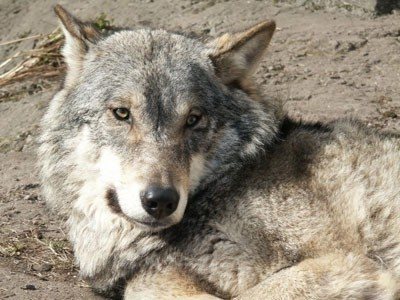

In general, somewhat smaller than the timber wolf, with sparser and coarser hair. The coloration along the back with noticeable predominance of rusty-gray or even brown hairs, and the flanks light gray. Its range includes the steppes of southern Russia, including the Pre-Caucasian, Caspian, Ural, and Lower Volga regions. It is poorly studied. The system of definite signs is not developed. Numbers are low, especially in the western parts of the range.
Siberian timber wolf.
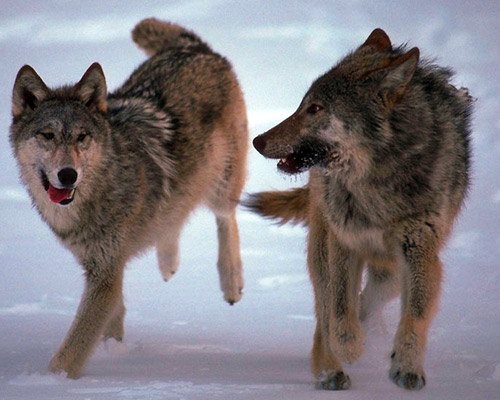

Also large beast, not inferior to previous subspecies in its average size. According to many scientists, it is still conditionally distinguished as a separate subspecies, as the systematics of Siberian wolves is poorly developed yet. The prevailing coloration is light gray, ochre tones are noticeable poorly or absent at all. Although the fur is not as high and silky as that of the tundra wolf, but it is also thick and soft. Its range is mostly considered Eastern Siberia, the Far East and Kamchatka, except for the tundra zone, and also Transbaikalia.










